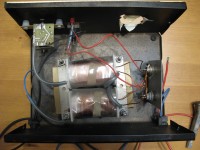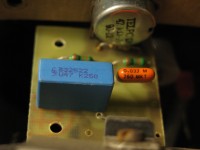Hello!
I would like to improve my ROMSTAN BP12 / 15 rectifier. First of all, I need to replace the ammeter, because the original tip dropped out, by the way I would be tempted to add a voltmeter. Hence my first questions:
- with what range should you choose an ammeter - up to 5, 8, 10 or 15A?
- with what range should you choose a voltmeter - up to 15 or 20V?
The charger is to be used to charge car batteries up to 100Ah, but it will be in the range of 40-80Ah.
How much can A get out of this transformer? Leave the original adjustment or replace / modify it? Leave the diodes or try to mount the rectifier bridge (some heat sink from the old computer will be found)? Maybe add some protection, although always before connecting the charger to the network, I connect the clamps to the battery terminals and only then turn on the power.
Here are photos of my rectifier:
[PS] I am not an electrician or electronics specialist, so please write to me like an amateur / idiot As if I can use a soldering iron and a meter
As if I can use a soldering iron and a meter 
Best regards and waiting for advice / suggestions
I would like to improve my ROMSTAN BP12 / 15 rectifier. First of all, I need to replace the ammeter, because the original tip dropped out, by the way I would be tempted to add a voltmeter. Hence my first questions:
- with what range should you choose an ammeter - up to 5, 8, 10 or 15A?
- with what range should you choose a voltmeter - up to 15 or 20V?
The charger is to be used to charge car batteries up to 100Ah, but it will be in the range of 40-80Ah.
How much can A get out of this transformer? Leave the original adjustment or replace / modify it? Leave the diodes or try to mount the rectifier bridge (some heat sink from the old computer will be found)? Maybe add some protection, although always before connecting the charger to the network, I connect the clamps to the battery terminals and only then turn on the power.
Here are photos of my rectifier:
[PS] I am not an electrician or electronics specialist, so please write to me like an amateur / idiot
Best regards and waiting for advice / suggestions





